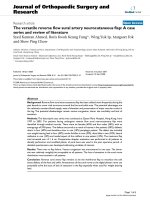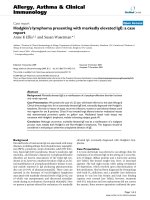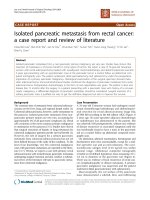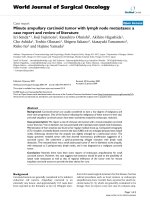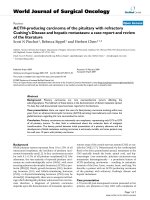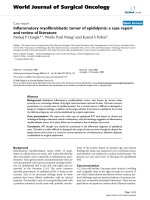Báo cáo khoa học: "Minute ampullary carcinoid tumor with lymph node metastases: a case report and review of literature" docx
Bạn đang xem bản rút gọn của tài liệu. Xem và tải ngay bản đầy đủ của tài liệu tại đây (400.84 KB, 5 trang )
BioMed Central
Page 1 of 5
(page number not for citation purposes)
World Journal of Surgical Oncology
Open Access
Case report
Minute ampullary carcinoid tumor with lymph node metastases: a
case report and review of literature
Eri Senda*
1
, Koji Fujimoto
2
, Katsuhiro Ohnishi
1
, Akihiro Higashida
1
,
Cho Ashida
1
, Toshio Okutani
1
, Shigeru Sakano
2
, Masayuki Yamamoto
2
,
Rieko Ito
3
and Hajime Yamada
1
Address:
1
Department of Gastroenterology and Hepatology, Shinko Hospital, Kobe, Hyogo 651-0072, Japan,
2
Department of Surgery, Shinko
Hospital, Kobe, Hyogo 651-0072, Japan and
3
Department of Pathology, Shinko Hospital, Kobe, Hyogo 651-0072, Japan
Email: Eri Senda* - ; Koji Fujimoto - ; Katsuhiro Ohnishi - ;
Akihiro Higashida - ; Cho Ashida - ; Toshio Okutani - ;
Shigeru Sakano - ; Masayuki Yamamoto - ; Rieko Ito - ;
Hajime Yamada -
* Corresponding author
Abstract
Background: Carcinoid tumors are usually considered to have a low degree of malignancy and
show slow progression. One of the factors indicating the malignancy of these tumors is their size,
and small ampullary carcinoid tumors have been sometimes treated by endoscopic resection.
Case presentation: We report a case of a 63-year-old woman with a minute ampullary carcinoid
tumor that was 7 mm in diameter, but was associated with 2 peripancreatic lymph node metastases.
Mild elevation of liver enzymes was found at her regular medical check-up. Computed tomography
(CT) revealed a markedly dilated common bile duct (CBD) and two enlarged peripancreatic lymph
nodes. Endoscopy showed that the ampulla was slightly enlarged by a submucosal tumor. The
biopsy specimen revealed tumor cells that showed monotonous proliferation suggestive of a
carcinoid tumor. She underwent a pylorus-preserving whipple resection with lymph node
dissection. The resected lesion was a small submucosal tumor (7 mm in diameter) at the ampulla,
with metastasis to 2 peripancreatic lymph nodes, and it was diagnosed as a malignant carcinoid
tumor.
Conclusion: Recently there have been some reports of endoscopic ampullectomy for small
carcinoid tumors. However, this case suggests that attention should be paid to the possibility of
lymph node metastases as well as that of regional infiltration of the tumor even for minute
ampullary carcinoid tumors to provide the best chance for cure.
Background
Carcinoid tumors are generally considered to be indolent
endocrine cell tumors. Ampullary carcinoid is an
extremely rare tumor, and approximately 105 cases have
been reported in the literature so far [1]. Whipple resec-
tion is the usual surgical treatment for this disease, but less
radical procedures such as local excision or endoscopic
ampullectomy have recently been reported for small car-
cinoid tumor [1-3], which are generally considered to be
benign. Here we report a very rare case of a minute amp-
Published: 22 January 2009
World Journal of Surgical Oncology 2009, 7:9 doi:10.1186/1477-7819-7-9
Received: 20 November 2008
Accepted: 22 January 2009
This article is available from: />© 2009 Senda et al; licensee BioMed Central Ltd.
This is an Open Access article distributed under the terms of the Creative Commons Attribution License ( />),
which permits unrestricted use, distribution, and reproduction in any medium, provided the original work is properly cited.
World Journal of Surgical Oncology 2009, 7:9 />Page 2 of 5
(page number not for citation purposes)
ullary carcinoid (7 mm in diameter) that showed regional
lymph node metastases, and we review the literature with
emphasis on the treatment of this disease.
Case presentation
The patient was a 63-year-old woman who had been
attending our hospital for hypercholestelemia once a
month. At her regular medical check-up, mild elevation of
liver enzymes was detected, and then she was admitted to
our hospital for further assessment. Contrast-enhanced
computed tomography (CT) revealed marked dilatation
of the common bile duct (CBD) and 2 enlarged lymph
nodes in the peripancreatic region (Figure 1-a, b). Endos-
copy showed that the ampulla was slightly enlarged by a
submucosal tumor, although its epithelium had a normal
appearance (Figure 2). Endoscopic retrograde cholangio-
pancreatography (ERCP) also demonstrated a markedly
dilated CBD with moderate stenosis in its distal portion
(Figure 3). The biopsy specimen obtained from inside the
papilla after endoscopic sphinctectomy contained tumor
cells with small round nuclei showing monotonous pro-
liferation. Immunohistochemical examination demon-
strated that the tumor cells were positive for
neuroendocrine markers, such as chromogranin, synapto-
physin, and neural cell adhesion molecule (NCAM), sug-
gesting that the lesion was a carcinoid. Although serum
serotonin and urinary 5-HIAA levels were within the nor-
mal range, a diagnosis of ampullary carcinoid tumor with
local lymph node metastases was preoperatively made.
She subsequently underwent the whipple resection with
extended lymph node dissection. We did not perform fro-
zen slide examination of the lymph nodes in the peripan-
creatic region before the resection, since the images of
those enlarged lymph nodes (e.g. round shape and well-
enhanced) shown by contrast-enhanced CT were typical
for metastasis from carcinoid tumor as shown in Figure 1-
a, b.
The resected tumor was a small yellowish submucosal
mass (7 mm in diameter) located at the ampulla of Vater
(Figure 4-a). Tumor cells were detected under the ampul-
lary epithelium, spreading over the sphincter of Oddi to
reach the muscularis propria, and infiltrating into the
CBD wall to create submucosal thickening (Figure 4-b).
The tumor cells were also found in 2 peripancreatic lymph
nodes (Figure 4-c). The tumor cells were strongly stained
by synaptophysin antibody (Figure 4-d. Immunohisto-
chemical staining using D2-40 antibody showed lym-
phatic involvement (Figure 4-e), and the Ki-67 labeling
index of the tumor cells determined with MIB-1 was 3.2%
(Figure 4-f) and overexpression of p53 was not detected.
According to the classification of neuroendocrine tumors
by The World Health Organization [4], our patient's
tumor with regional lymph node metastases and an MIB-
1 proliferative index of more than 2% was a well-differen-
tiated endocrine carcinoma (malignant carcinoid). The
patient remains free of disease and is leading a normal life
at 24 months after the operation.
Discussion
Carcinoid tumor is generally recognized to be a low-grade
endocrine cell tumor derived from the endoderm. The
Contrast-enhanced CT shows the markedly dilated CBD and 2 enlarged lymph nodes in the peripancreatic regionFigure 1
Contrast-enhanced CT shows the markedly dilated CBD and 2 enlarged lymph nodes in the peripancreatic
region. (a) The marked dilated CBD (arrow) and one of 2 enlarged lymph nodes near the upper border of the pancreas
(arrow head) are detected. (b) Another enlarged lymph node near the lower border of the pancreas (arrow head) is found.
World Journal of Surgical Oncology 2009, 7:9 />Page 3 of 5
(page number not for citation purposes)
most common site for this tumor in the digestive tract is
the appendix, followed by the distal small intestine, the
rectum, and the stomach [5]. Ampullary carcinoids are
rare (0.05%), being even less frequent than tumors of the
duodenum (2%). To date, a total of 105 cases of this
tumor have been reported in the literature [5]. Jaundice
(53.1%), pain (24.6%), pancreatitis (6.0%), and weight
loss (3.6%) are common presenting symptoms [5,6].
Because ampullary carcinoid tends to proliferate under
intact normal epithelium, this might explain the difficulty
in obtaining accurate biopsy specimens by endoscopic
examination and the low rate of correct preoperative diag-
nosis (14%) [5,7].
Many authors have suggested that Whipple resection is
the best surgical option for ampullary carcinoid tumors,
and the prognosis has been thought to be good with an
overall survival rate of approximately 90%[7]. Mean-
while, Hwang et al. have recently analyzed the clinico-
pathological features and outcomes of 10 ampullary
carcinoid patients who underwent the Whipple resection,
and described that the mean tumor size was 2.1 +/- 1.3 cm
and the overall survival rates were 90% at 1 year and 64%
at 3 years, respectively [8]. This might suggest that this
tumor is associated with a relatively poor prognosis than
we think.
On the other hand, the tumors that were less than 20 mm
in diameter have recently been managed by local excision
[7,9], and some cases of endoscopic ampullectomy have
also been reported [1-3]. Although less radical treatment
strategies have been investigated to reduce surgical mor-
bidity and preserve organ function as a reasonable alter-
native to pancreatic resection, there is a risk of incomplete
tumor removal if preoperative evaluation is not accurate.
Clements et al. surveyed the reports on 90 patients with
ampullary carcinoid and investigated their surgical man-
agement. Twenty-two patients were treated with local
excision of the tumor, which was performed on patients
with tumors smaller than 20 mm in diameter. They found
that one out of 22 patients died of local recurrence at 20
months after local resection [10]. Furthermore, some
authors have reported that 40–50% of ampullary carci-
noid tumors smaller than 20 mm in diameter were associ-
ated with metastatic disease [10,11]. Generally, it has
been demonstrated that duodenal carcinoid tumors
smaller than 20 mm might have a 4% incidence of metas-
tases. These findings suggest that with respect to ampul-
lary carcinoids, tumor size is not a reliable factor of
aggressiveness.
In the present patient, 2 lymph node metastases were
clearly demonstrated by CT. This finding enabled us to
ERCP shows severe stenosis of the distal portion of the CBD and marked proximal dilationFigure 3
ERCP shows severe stenosis of the distal portion of
the CBD and marked proximal dilation. The main
pancreatic duct is not dilated.
Endoscopy shows a slightly enlarged ampullary region, sug-gesting the existence of a submucosal tumor because the epi-thelium has a normal appearanceFigure 2
Endoscopy shows a slightly enlarged ampullary
region, suggesting the existence of a submucosal
tumor because the epithelium has a normal appear-
ance.
World Journal of Surgical Oncology 2009, 7:9 />Page 4 of 5
(page number not for citation purposes)
suspect its malignant nature preoperatively, so the Whip-
ple procedure with regional lymph node dissection could
be done. Histopathological examination revealed micro-
scopic invasion of the lymphatics and the Ki-67 labeling
index was relatively high (3.2%), even though the primary
tumor was only 7 mm in diameter.
Although we also need to establish a method for identify-
ing the extent of regional infiltration in order to determine
the best treatment strategy for small ampullary carcinoids,
it seems to be hard to evaluate the extent of microscopic
lymphovascular invasion even if modalities such as EUS
are used. Therefore, we suggest that the Whipple proce-
dure currently remains the first choice for even small amp-
ullary carcinoids in order to achieve complete resection of
the tumor and regional lymph nodes, and that this offers
the best chance of achieving a cure. Less radical endo-
scopic procedures should only be considered when
patients have a condition that prevents the use of the
Whipple procedure.
Conclusion
Small ampullary carcinoids (less than 10 mm in diame-
ter) are generally considered to be benign and there have
been some reports of local excision or endoscopic ampul-
lectomy for those tumors. However, we encountered the
patient who had a minute ampullary carcinoid (7 mm in
diameter) associated with regional lymph node metas-
tases. This case provides evidence that carcinoid of the
ampulla of Vater, irrespective of its size, might have the
potential to metastasize to the regional lymph nodes,
therefore, that the patients should be examined in detail
concerning the existence of metastases as well as that of
regional infiltration of the tumor.
Consent
Written informed consent was obtained from the patient
for publication of this case report and the accompanying
images. A copy of the written consent is available for
review by the Editor-in-Chief of this journal.
Competing interests
The authors declare that they have no competing interests.
Authors' contributions
ES drafted the case presentation and literature review sec-
tions of this manuscript. KF performed the operation,
conceived of this case report, and helped to draft the man-
uscript. SS, MY performed the operation and postopera-
tive management. KO, AH, CA, TO, HY carried out
(a) The resected specimen contains a small yellowish submucosal tumor (approximately 7 mm in diameter) located at the ampulla of Vater (arrow)Figure 4
(a) The resected specimen contains a small yellowish submucosal tumor (approximately 7 mm in diameter)
located at the ampulla of Vater (arrow). (b) Monotonous tumor cells with small round nuclei are seen (hematoxylin and
eosin staining, × 400). (c) Carcinoid tumor cells within a peripancreatic lymph node (× 200). (d) The tumor cells are positive
for synaptophysin, a neuroendocrine marker (× 40). (e) Endolymphatic tumor emboli are shown by staining with D2-40 anti-
body (× 400). (f) Positive staining for MIB-1 antibody is seen in approximately 3.2% of the tumor cell nuclei (× 400).
Publish with BioMed Central and every
scientist can read your work free of charge
"BioMed Central will be the most significant development for
disseminating the results of biomedical research in our lifetime."
Sir Paul Nurse, Cancer Research UK
Your research papers will be:
available free of charge to the entire biomedical community
peer reviewed and published immediately upon acceptance
cited in PubMed and archived on PubMed Central
yours — you keep the copyright
Submit your manuscript here:
/>BioMedcentral
World Journal of Surgical Oncology 2009, 7:9 />Page 5 of 5
(page number not for citation purposes)
endoscopic examinations for the diagnosis. RI performed
the pathological examination. All authors read and
approved the final manuscript.
Acknowledgements
We are grateful to Ms. Yuko Nishikawa (Pathology Department, Shinko
Hospital) for her technical assistance in tissue preparation.
References
1. Pyun DK, Moon G, Han Jimin, Kim MH, Lee SS, Seo DW, Lee SK: A
carcinoid tumor of the ampulla of Vater treated by endo-
scopic snare papillectomy. The Korean journal of internal medicine
2004, 19:257-260.
2. Gilani N, Ramirez FC: Endoscopic resection of an ampullary
carcinoid presenting with upper gastrointestinal bleeding: A
case report and review of the literature. World Journal of Gas-
troenterology 2007, 13(8):1268-1270.
3. Chahal P, Prasad GA, Sanderson SO, Gostout CJ, Levy MJ, Baron TH:
Endoscopic resection of nonadenomatous ampullary neo-
plasms. J Clin Gastroenterology 2007, 41(7):661-666.
4. Solcia E, Klöppel G, Sobin LH: Histological Typing of Endocrine
Tumours (International Histological Classification of
Tumours). WHO: Springer Verlag; 2000:61-68.
5. Hartel M, Wente MN, Sido Bernd, Friess H, Buchler MW: Cartinoid
of the ampulla of Vater. Journal of Gastroenterology and Hepatology
2005, 20:676-681.
6. Albizzatti V, Casco C, Gastaminza M, Speroni A, Mauro G, Rubio
HW: Endoscopic resection of two duodenal carcinoid tumor.
Endoscopy 2000, 85:1241-1249.
7. Hatzitheoklitos E, Buchler MW, Friess H, Poch B, Ebert M, Mohr W,
Imaizumi T, Beger HG: Carcinoid of the amupulla of Vater. Clin-
ical characteristics and morphologic features. Cancer 1994,
73(6):1580-1588.
8. Hwang S, L S, Lee YJ, Han DJ, Kim SC, Kwon SH, Ryu JH, Park JI, Lee
HJ, Choi GW, Yu ES: Radical surgical resection for carcinoid
tumors of the ampulla. J Gastrointest Surg 2008, 12(4):713-717.
9. Hwang S, Moon KM, Park JI, Kim MH, Lee SG: Retroduodenal
resection of ampullary carcinoid tumor in a patient with cav-
ernous transformation of the portal vein. Journal of Gastrointes-
tinal Surgery 2007, 11(10):1322-1327.
10. Clements WM, Martin SP, Stemmerman G, Lowy AM: Ampullary
carcinoid tumors: Rationale for an aggressive surgical
approach. Journal of Gastrointestinal Surgery 2003, 7(6):773-776.
11. Ricci JL: Carcinoid of the ampulla of Vater. Cancer 1993,
71(3):
686-690.
